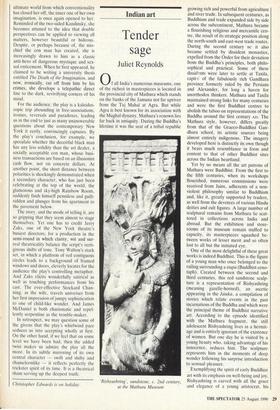New York theatre
Six Degrees of Separation (Mitzi E. Newhouse Theater, Lincoln Center)
Trickery and truth
Douglas Colby
0 verhead, in the Fifth Avenue apart- ment of a private art dealer and his wife, a two-sided Kandinsky slowly revolves, re- vealing on its main face the cosmic collision of worlds. The meaning of the overlapping circles probably escapes the couple for they, like many arrivistes, view such ac- quisitions more for their prices than for their truth. Theirs is an existence of mater- ialist insularity. And, ironically, only an apocalyptic occurrence like the one in the canvas right under (or above) their noses could catapult them to an awareness of the infinite worlds beyond.
In John Guare's Six Degrees of Separa- tion, a spell-binding tale of intrigue dressed in comedy and based on a true-life series of events in 1983, the wife is hurled into just such an enlightenment. That awakening begins one evening when a young and polished black man finds unlikely passage into the couple's home and confidence. The youth, a visitor to the city, who by his own account has just been mugged in Central Park, seeks refuge with them as the parents of his Harvard schoolmate. They know nothing about him, but when he lets slip that he is the son of Sidney Poiter — in their opinion the most impress- ive of black celebrities — he is welcomed into their circle and invited to stay the night. A few hours later the hostess accidentally discovers him in the guest room having sex with a male pick-up and outraged she sends him into the night. Nothing has been stolen, but she begins to suspect that he is an impostor, a fact that is eventually corroborated.
As classically happens in the case of an enigmatic confidence man and the unmask- ing of falsity, a greater truth starts to unfold. In the days that follow, the young man winds his way in and out of other households, elite and otherwise, making the same preposterous claims and in one instance precipitating tragedy. Meanwhile, the couple solves the mystery — as does the audience, through flashbacks — of the events leading to his initial arrival at their doorstep. Guare, in a sweeping structural masterstroke, breaks down all divisions of time, space and social strata, even between tragedy and comedy and between on-stage and off, to expose the sometimes hidden connections that exist between all worlds. The worlds that are dramatised here, ultimately if not always at first, reveal themselves to be tied, contiguously or distantly, to that of the couple. Any single one is removed from another, at most, by only 'six degrees'. In the precariousness of modern times the security of self-contained isolation is an illusion.
As the purview of the action widens, so the consciousness of the wife expands. The `I've been designated a rare breed — and you've been designated medium nil e.' ultimate world from which conventionality has closed her off, the inner one of her own imagination, is once again opened to her.
Reminded of the two-sided Kandinsky, she becomes attuned to the idea that double perspectives can be applied to viewing all matters, however beautiful or hideous. Despite, or perhaps because of, the mis- chief the con man has created, she is increasingly drawn to him as a classic anti-hero of dangerous mystique and sex- ual enticement. When he first appeared, he
claimed to be writing a university thesis entitled The Death of the Imagination, and
now, ironically, cut off from him by his crimes, she develops a telepathic direct line to the dark, revivifying corners of his mind.
For the audience, the play is a kaleidos- copic trip abounding in free-associations, ironies, reversals and paradoxes, leading us in the end to just as many unanswerable questions about the contemporary New York it eerily, convincingly captures. By the play's conclusion, for example, we speculate whether the deceitful black man has any less solidity than the art dealer, a socially acceptable con man, whose busi- ness transactions are based on an illusionist cash flow, not on concrete dollars. At another point, the short distance between polarities is shockingly demonstrated when a secondary character, who has just been celebrating at the top of the world, the glamorous and sky-high Rainbow Room, suddenly finds himself penniless and guilt- ridden and plunges from his apartment to the pavement below.
The story, and the mode of telling it, are so gripping that they seem almost to stage themselves. Yet one has to credit Jerry Zaks, one of the New York theatre's busiest directors, for a production in the semi-round in which clarity, wit and sur- real theatricality balance the script's verti- ginous shifts of tone. Tony Walton's stark set, in which a platform of red contiguous circles leads to a background of framed windows and doors, cleverly locates for the audience the play's controlling metaphor. And Zaks elicits wonderfully satirical as well as touching performances from his cast. The ever-effective Stockard Chan- cing, as the wife, travels universes from her first impression of jumpy sophistication to one of child-like wonder. And James McDaniel is both charismatic and repel- lently serpentine as the trouble-maker.
In retrospect, we may question some of the givens that the play's whirlwind pace seduces us into accepting wholly at first. On the other hand, if we feel that on some level we have been had, then the added twist makes us admire the play all the more. In its subtle mirroring of its own central character — swift and shifty and chameleonlike — it reflects perfectly the trickster spirit of its time. It is a theatrical sham serving up the deepest truth.











































 Previous page
Previous page